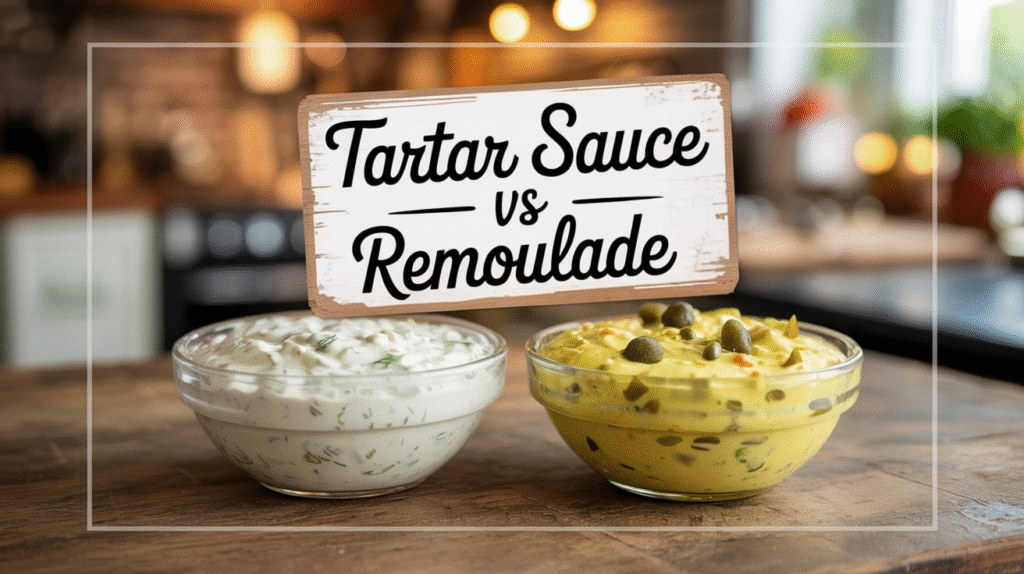Affiliate Disclosure: PantryBrands.co.uk is a participant in the Amazon.co.uk Associates Programme. As an Amazon Associate, we earn from qualifying purchases made through links on this site.
The main difference between tartar sauce and remoulade is that tartar sauce is a mayonnaise-based condiment with gherkins, capers and herbs, while remoulade is a spicier, mustard-forward sauce with additional seasonings. Both are creamy accompaniments to seafood, but their flavour profiles, ingredients and regional uses set them apart.

Why the distinction matters
Understanding the difference helps you choose the right condiment for your meal. Although they share a base, tartar sauce is sharper and more citrus-driven, while remoulade leans towards spice and depth.
Shared roots but distinct identities
Both sauces have French origins but evolved differently.
- Tartar sauce spread widely in Britain and became essential with fish and chips.
- Remoulade developed in France and later gained prominence in Louisiana Creole cooking.
Complementary but not interchangeable
Though similar, they suit different dishes.
- Tartar sauce excels with fried or grilled white fish.
- Remoulade shines with spiced dishes, shellfish and meats.
Ingredients that define each sauce
While both begin with mayonnaise, the flavouring ingredients set them apart.
Tartar sauce ingredients
Tartar sauce is crisp, tangy and herbaceous.
- Core elements: mayonnaise, gherkins/cornichons, capers, lemon juice.
- Optional herbs: parsley, dill or chives for freshness.
Remoulade ingredients
Remoulade is richer and more complex.
- Mustard: often Dijon, giving heat and depth.
- Additional spices: paprika, cayenne, garlic and anchovies may be included.
- Extras: pickles, herbs and sometimes horseradish for intensity.
Flavour profile comparison
Each sauce’s taste results from its ingredient mix.
Tartar sauce flavour
Fresh and tangy, it complements delicate seafood.
- Bright lemon acidity balances fried foods.
- Crunchy pickles add texture without overwhelming.
Remoulade flavour
Bolder and spicier, it works with robust flavours.
- Mustard and paprika give warmth and depth.
- A touch of sweetness or garlic enhances complexity.
Regional uses and culinary traditions
The sauces reflect different culinary cultures and traditions.
Tartar sauce in Britain
A staple of fish and chip shops nationwide.
- Served chilled alongside battered cod or haddock.
- Also used with prawns, crab cakes and baked fish.
Remoulade in France and Louisiana
Distinct versions exist in European and American kitchens.
- French remoulade: mustard-heavy, served with cold meats and salads.
- Louisiana remoulade: spicier, with hot sauce or cayenne, used with shrimp and fried seafood.
Best pairings for each sauce
The right pairing brings out the best in both condiment and dish.
Tartar sauce pairings
Classic and versatile for seafood lovers.
- Fried white fish such as cod, haddock and plaice.
- Cold seafood like prawns and crab salad.
Remoulade pairings
More adventurous with spice-driven dishes.
- Cajun-style fried shrimp or crawfish.
- Cold meats, sandwiches and roasted vegetables.
Health and nutrition considerations
Both sauces are calorie-dense due to their mayonnaise base, but slight nutritional differences exist.
Tartar sauce nutrition
Generally lighter in spice and additives.
- Around 60–80 calories per tablespoon.
- Sodium comes mainly from pickles and capers.
Remoulade nutrition
Spicier and sometimes saltier depending on the recipe.
- Calories similar to tartar sauce due to mayonnaise.
- Higher sodium and spice content from mustard and seasoning.
Homemade versus store-bought
Both sauces are available in jars, but homemade versions allow flexibility.
Benefits of homemade tartar sauce
- Control over salt, lemon and herbs.
- Fresher taste compared with mass-produced versions.
Benefits of homemade remoulade
- Customisable spice levels.
- Ability to choose between French-style mustard or Louisiana spice blends.
How to decide which to use
Choosing between tartar sauce and remoulade depends on the dish and your taste preferences.
Choose tartar sauce when
- Serving classic British fish and chips.
- Wanting a fresh, tangy condiment with lighter seafood.
Choose remoulade when
- Cooking spiced or Creole-inspired seafood dishes.
- Looking for a sauce that stands up to stronger flavours.
FAQs
Here are some questions and answers about tartar sauce vs remoulade.
Is tartar sauce the same as remoulade?
No, tartar sauce is tangy and pickle-based, while remoulade is mustard-forward and spicier, often with paprika or cayenne.
Which is healthier, tartar sauce or remoulade?
Both are similar in calories, but tartar sauce is usually lower in sodium and spice, while remoulade may contain more seasoning and mustard.
Can I substitute tartar sauce for remoulade?
You can in a pinch, but the flavours differ. Tartar suits mild fish, while remoulade is better for spiced or robust dishes.
Is remoulade popular in the UK?
Not as much as tartar sauce. Remoulade is more common in France and Louisiana, though niche versions are available in UK supermarkets.
What dishes are best with remoulade?
Louisiana-style shrimp, cold meats, po’boy sandwiches and spiced seafood are classic remoulade pairings.
Can I make a milder remoulade?
Yes, by reducing or omitting cayenne and hot sauce, you can create a creamier, less spicy version closer to tartar sauce.
